‘Natural Magic’ was a 2009 AHRC sponsored project ( AHRC Research Leave Award 2007) relating to stereoscopic photography in collaboration with Professor Nicholas Wade, a visual psychologist at the University of Dundee.
The project is an interdisciplinary investigation into two-dimensional and three-dimensional awareness. It investigates areas of commonality between visual science and visual art in order to present a series of stereoscopic images which reflect on a series of visual and psychological phenomena, whilst referring to themes relating to art, science, photography and optics.
Exhibited as a series of large-scale photographic images which can be viewed stereoscopically in a solo exhibition in The Royal Scottish Academy, Edinburgh, March 2009. Publication documenting the research funded by the RSA (Sir William Gillies Bequest), Carnegie Trust, and School of Fine Art Research. This exhibition toured to Inverness Museum and Art Gallery (23/12/09-13/2/10). This was the first venue in a series in the Highlands and is a result of a collaboration between the RSA, the National Galleries and Highland Region. Other venues included Swanson Gallery, Thurso (20/2/10 – 27/3/10) and St Fergus Gallery, Wick (3/4/10 – 1/5/10).
Below is a selection of the text and a PDF of the exhibition catalogue ‘Natural Magic’, published by The Royal Scottish Academy to accompany the exhibition Natural Magic held at The Royal Scottish Academy, Edinburgh from 6 March-5 April 2009.
ISBN 978-0-905783-18-5
Foreword
Professor Ian Howard RSA
In the title of this exhibition, Natural Magic, Calum Colvin is invoking centuries of magical practice from the ancients such as Abbaris the Hyperborean, Hermippus, Mercurius Tresmegistus, Porphyrius, Dardanus, Orpheus the Thracian, Gog the Grecian, and Germa the Babylonian, through Pythagoras, Democritus, and Plato, to the alchemists, Fludd, Dee, Kelly, Maier and Newton, and on to the popular entertainments and illusions of the Victorian parlour and experimental laboratory.
The exhibition title has direct antecedents. Magic naturalis (1558), the Italian Renaissance philosopher Giambattista Della Porta’s major work, argues that the natural world can be manipulated by the natural philosopher through theoretical and practical experiment and discusses subjects including demonology, magnetism and the camera obscura. Much later, in Scotland, in his compilation of Letters on Natural Magic (1832), David Brewster discusses various natural phenomena as used in magic such as: optical illusions, spectral illusions, magic lanterns, feats of strength, automata, Babbage’s calculating machines, ventriloquism, wonders of chemistry, alchemy, breathing fire, and spontaneous combustion.
Brewster is the seminal figure in this exhibition. Colvin’s photographic portrait of Brewster (which is viewed stereoscopically and therefore perceived in three-dimensions) synthesises the many complex elements in this exploration of the relationship of art, science and photography.
Brewster is notable for his key inventions: the kaleidoscope and the stereoscope. His experiments with optical instruments and lenses led him in to the camera and the development of the photographic image. It was he who introduced Robert Adamson to David Octavius Hill RSA, thus enabling the most important association in the history of photography.
D.O.Hill, painter, was the Secretary of the Royal Scottish Academy from 1830-1869. In the 1850’s he proposed the establishment of a department of photography at the RSA and encouraged the collection of early photographic work. The initiative was short lived, and, although many academicians have used photography in their work, it would be a long time before photography was given the status of an art form alongside painting, sculpture and architecture.
In Natural Magic, through thematic concept, historical reference, formal construction, technical intricacy, and illusion, Calum Colvin offers an extraordinarily imaginative insight into a time of great change in our understanding of visuality and cognition.
Natural Magic: Calum Colvin and the legacy of Sir David Brewster
Tom Normand
At every level Calum Colvin’s photography is concerned with invention: the constructed invention of the stage-set that provides the platform for his tragi-comic theatrical tableaux; the painted invention of episodes and scenes that populate his pictures with an extraordinary dramatis personae; the invention of a photographic print that conjures an unfamiliar dreamscape. And finally, firstly perhaps, the creative invention that imagines magical illusions, rhetorical correspondences, outlandish alliances and the subtlest of metaphorical allusions
Throughout his career this invention has arced across a number of resonant themes: the sense of an individual but generic odyssey; the burden of history and culture; the frailty and absurdity of the human project; the haphazard nature of myth and its capricious shadow, reality. And finally, firstly perhaps, the enigma of identity: that is, personal, social, historical, national and cultural identity.
The recurrent motif in all these inventions and imaginings is the camera, or rather the unreliable evidence that is the photograph. Amongst the wreckage and fragments that inhabit Colvin’s sets, the cultural debris and abandoned ornaments, there exists the inevitable reference to the camera and its elusive product. Mirrors, lenses, projectors, screens, photographic samples and quotations, scraps of analogue and digital imagery, all inhabit the ordered chaos of Colvin’s pictures. Here, they reference the erratic and threadbare nature of the photograph’s ‘truth’. They are the insistent reminders that these three dimensions are two, that the scenario depicted is fictional, that meaning is negotiated, that everything here is illusion, and, that the eye – and the lens – will deceive.
Small wonder then that a photographer with Colvin’s epic ambitions will return to the early history of the medium, for the moment at which the photograph is invented and developed, and its creative potential first explored, was the point at which its essential ambiguity was first realised. There, in the middle years of the nineteenth century, when the camera and the photograph were undergoing myriad transformations, the medium released its many perplexing possibilities. And there, at the epicentre of this storm of invention was the prickly personality of David Brewster.David Brewster (1781-1868) was, in his academic life, a natural philosopher. This polymathic discipline has its modern parallel in physics but traditionally incorporated the entire study of the natural world. Brewster would ably fulfil this expansive bailiwick with research in everything from astronomy to the history of science. His core engagement, however, was the science of optics. Here, he would experiment in refraction and developed a multitude of scientific instruments, or ‘new philosophical instruments’ as he would call them, that explored the physical horizons of human vision. Though he would later become Principal of the United Colleges of St Leonard and St Salvator at the University of St Andrews, in 1838, and would accept the subaltern position of vice-chancellor of Edinburgh University in 1859, he remains significant for these early experiments with optical instruments.
In the 1830s, and beyond, this would naturally lead Brewster into experiments with lenses, the early forms of the camera, and the development of the photograph. An associate and confidant of William Henry Fox Talbot from the middle years of the 1830s he secured the patent-free use of the Calotype process in Scotland. Famously it was Brewster who promoted the St Andrews Literary and Philosophical Society wherein the local academics and professionals would experiment with the new medium. From this group Brewster selected Robert Adamson and introduced him to the painter David Octavius Hill, thus establishing the most important photographic partnership in the historical canon.
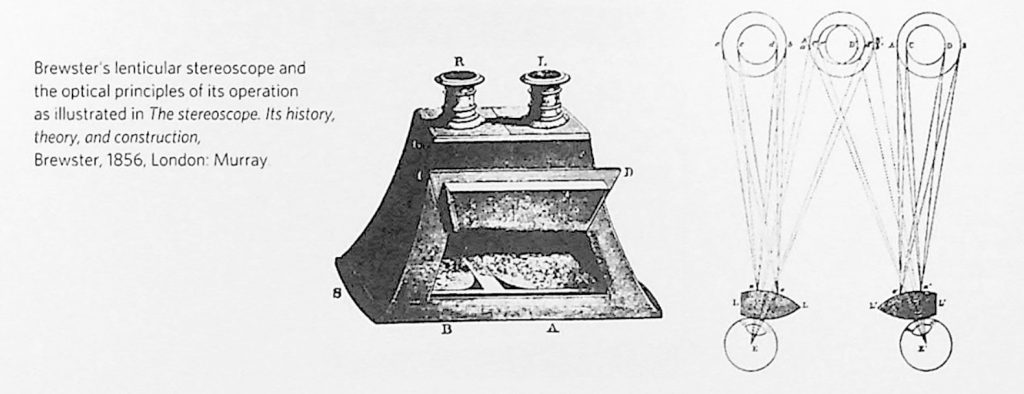
Brewster, however, remains most notable for two key inventions that might best be described as scientific toys: the kaleidoscope and the stereoscope. With both these inventions, as elsewhere in his life, Brewster generated more controversy than celebration. The kaleidoscope, surely one of the most popular and charming of optical playthings, was invented by Brewster after his optical experiments of 1816 and patented in 1817. Controversy followed as it was noted that the principles of the kaleidoscope had been know to science for centuries, and as Brewster’s patent was undermined. The ensuing public squabbles continued for over fifty years with Brewster publishing his self-justifying Treatise on the Kaleidoscope as late as 1858. A parallel controversy followed his invention of the stereoscope which Brewster announced in 1849. In fact this was a development of the mirror stereoscope invented by Charles Wheatstone as early as 1832, but it was Brewster’s lens-based ‘lenticular stereoscope’ that would be demonstrated at The Great Exhibition in 1851. From this point his model, accompanied by his binocular camera, would become the market leader in what was a popular obsession. Typically, Brewster remained mired in dispute on the issue of the ‘priority’ of invention for the remainder of his life.It is this last invention, and the accompanying controversy, that has intrigued Calum Colvin and becomes the compass of his new work. He has explored the problematic of Brewster’s inventions, and the contingency of his interest in vision and the photographic image, to offer an imaginative survey of the disputed terrain. And here he has realised all the nuanced tropes of his oeuvre.
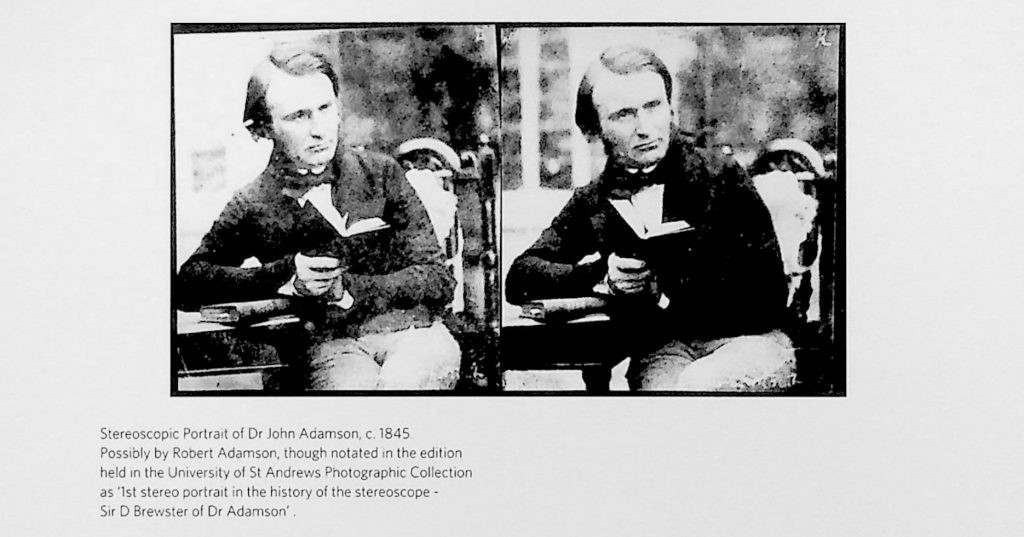
The portrait study has become the vehicle for Colvin’s discourse on Brewster’s world, and it is Brewster who is his first subject. His epic study of the irascible Brewster is recognisably fashioned on the scientist’s carte-de-visite. The elderly, whiskered Victorian is presented with all the paraphernalia of the stereoscope in his orbit There are models of stereoscopes to his left and a prime example of a stereoscopic print to his right. In the latter case an image of Dr John Adamson1 the brother of Robert Adamson who most probably took this image circa 1845 (although in the manner of photography’s incautious early history the catalogued work has a pencil notation ‘1st stereo portrait in the history of the stereoscope – Sir D Brewster of Dr Adamson’).2 The mirror, again to the left of the portrait head, plays upon the idea of the camera lens and references also the dialectic between the mirror and lenticular stereoscopes.
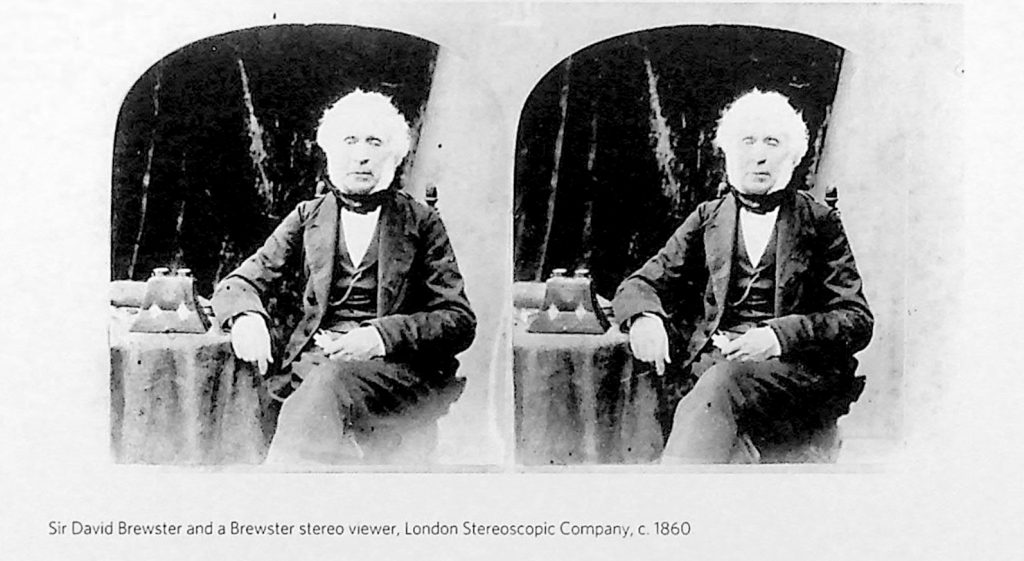
The set itself is composed of a desk with piled books, the evidence of Brewster’s research, and, laid into this space, a ladder, the coded symbol of enlightenment and intellectual progress3 The palette of the image is tones of grey, while the background a pattern of flecked strokes and cross-hatchings. Evidently this alludes to the monochrome of the early photographic experiments and the grained surface of the photographic print. In juxtaposition to this the desk holds some painter’s brushes while, propped against the back wall, there rests an artist’s easel Colvin is carefully echoing his own practice as artist and photographer, but is also revisiting that core debate of the nineteenth century the relationship of the photograph to the discrete realms of art and science.
This photographic portrait is a tour-de-force of Colvin’s complex art: it is replete with metaphor and symbol, citation and suggestion, quotation and contradiction. Moreover it is designed to be viewed stereoscopically Colvin has created two pictures of the set, each from a slightly different angle to the image, and so, when viewed through a stereoscopic apparatus it is perceived in three-dimensions. Hence, Brewster’s toy captures Brewster’s portrait in a reflexive and ironical prism.
Echoing the dialectic of the stereoscopic image Colvin has created a corresponding portrait of the London based experimental scientist Charles Wheatstone. Wheatstone (1802-1875) is best remembered for his role in developing telegraphy but like Brewster he was a multitalented physicist.
He certainly invented a form of kaleidoscope in the 1820s and was an originator of the stereoscope in the period after 1833. Though Brewster adapted and popularised the stereoscope the debate on its ‘invention’ and origin became a feature of scientific discourse in the 1850s and Brewster was intensely vocal in claiming his authorship. This dispute is mirrored in Colvin’s portrait of Wheatstone. Placing the depiction of Wheatstone in the same set as his image of Brewster, replete with desk, books, ladder, easel and mirror, Colvin decorates the Wheatstone tableaux with small circular images of Brewster to the right of the principal subject. These are accompanied by diagrams of Wheatstone’s symbolic notations concerning the nature of stereoscopic vision, and, totemic representations of the flags of St Andrew and St George Already the debate is projected into one of national history and national identity
If the debate concerning priority is here morphed into a discourse on national identity then the absurdity of this construct is referenced in a further symbolic figure lying to the right of the Wheatstone portrait. A scrap of drawing, repeated and mirrored, has carefully been placed within the frame. This is the renowned sketch, or rather sketches, by Jacopo Chimenti (1551-1640) showing a young man holding those essential instruments of mathematics and perspective, a compass and a plumb-line. In the fiery debate between Brewster and Wheatstone these sketches became crucial for they seemed to indicate a knowledge of the stereoscopic process extant in the period circa 1600, for these drawings, set alongside each other, presented the possibility of a reading in three-dimensions. This offered to Brewster the opportunity to undermine Wheatstone’s undeniable claim to ‘priority’.[1] Colvin’s Chimenti is a poignant reflection upon this delusional claim for Chimenti’s drawings were subject to the closest scrutiny by nineteenth-century scientists and shown to fall short of a true stereoscopic intent.
Circling this unresolved dialectic is a maelstrom of creativity and invention that is typical of Colvin’s fertile and subtle imagination. Portraits of Robert Burns and Lord Byron echo the discord and dislocation of the Brewster and Wheatstone controversy. The Scottish bard juxtaposed to the anglo-scot romantic poet in a confusion of entangled identities and mirrored psychologies. The profiles of the two poets a thesis and antithesis of ‘Scottish character’, a kaleidoscope of potential connections or a stereoscopic vision of elemental doublings and contingencies.
Even more elusive are the subject pictures in this fascinating collection. The Rabbit-hand, however, carries a direct, if obscure, relation to Brewster. In her book Phantasmagoria Marina Warner has commented on how ‘David Brewster…attended phantasmagorias and gave highly detailed descriptions of the moving eyes and lips of the spectres, of the dissolves, fades, and other proto-cinematic effects…’[1] Brewster, like many Victorians was in thrall to the popular entertainments that promised magic and illusion and every variety of fantastic excitement His interest, however, was in the scientific investigation of these deceptions principally because their success depended upon trickeries that related to the science of vision. Moreover, in 1832, he would publish Letters on natural magic addressed to Sir Walter Scott, Bart. Scott was ever the spectral presence in the early history of photography, but
Brewster’s ‘letters’ were created to explain the myriad enchantments that masqueraded as ‘supernatural’. Colvin’s Rabbit-hand is a playful reflection of these illusions that properly belong to the pre-history of photography. A chair rests besides a slide-projector’s stand where the knotted hands cast a shadow image of a rabbit onto a screen: a comic foil to Brewster’s researches in visual deceptions And, within this context the insistently stereoscopic Vanitas, along with the esoteric GOD photographs, become poignant counterpoints to this vainglorious search for truth and reality
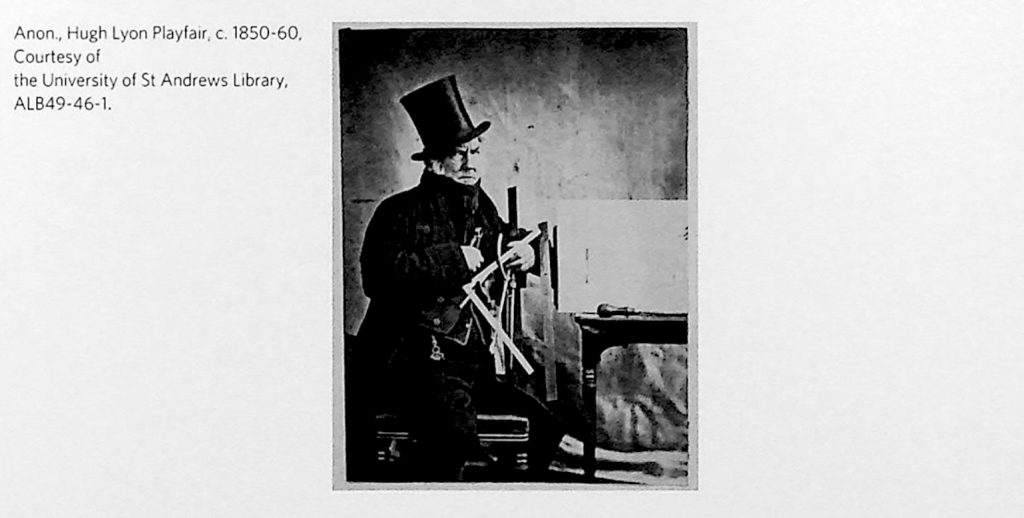
The summation of this comic-heroic narrative may be the declamatory self-portrait titled Natural Magick. Here is the artist brandishing the tools of his trade. A frame and projector deceptively mounted in his right hand while delineating his eye. A triangle in his left hand which is at once a geometrical apparatus but with Escher-like grace folds its planes into a Saltire. All this, an exercise in metaphor, symbol and allusion. This is a remarkable image, though rooted in fine art self-portraits, and even in photographic convention. Take, for example, the nineteenth-century portrait of Brewster’s associate Hugh Lyon Playfair, possibly by John Adamson himself though more probably by Thomas Rodger. Here the provost of St Andrews and noted urban reformer brandishes the tools of his ‘magical’ transformations, and alludes to the alchemy of art. Likewise, in Colvin’s self-portrait, the themes, correspondences, symbols, allegories and counterpoints of epic project is reprised. The mirror and lens, the screen and easel, the frame and photograph, the skull and its anamorphic reflection all take their place in this kaleidoscope of perspectival deception. And with this Brewster’s world, too, is reprised. The fascination with tricks of sight and seeing, the observations on the nuanced reality of binocular vision, the restless searching for a three dimensional world gleaned from the relentless two-dimensionality of the picture-plane. This is surely a ‘natural magic’ but one that is bound to the captivating mechanism of the camera and the mysterious enchantment that the photograph presents to the eye.
- Dr John Adamson (1809-1870) was a medical practitioner in St Andrews and an associate of David Brewster; he was a member of the St Andrews Literary and Philosophic Society. He had skills as a chemist and so experimented with the Calotype process, and was a noted photographer.
2. See University of St Andrews Photographic Collection,
http://special.st-andrews.ac uk/saspecial/index.php?a=wordsearch&s=item&key=WczoxMjoiam9obiBhZGFtc29uljs=&pg=82
3. Interestingly the ladder was a key motil in works by Fox Talbot. See The Ladder. 1844, and The Haystack. 1844
4. For the fullest discussion of this quarrel see N. J Wade The Chimenti Controversy, Perception, vol. 32 (2), 2003.
5. Marina Warner, Phantasmagoria, Oxford 2006, p. 153.
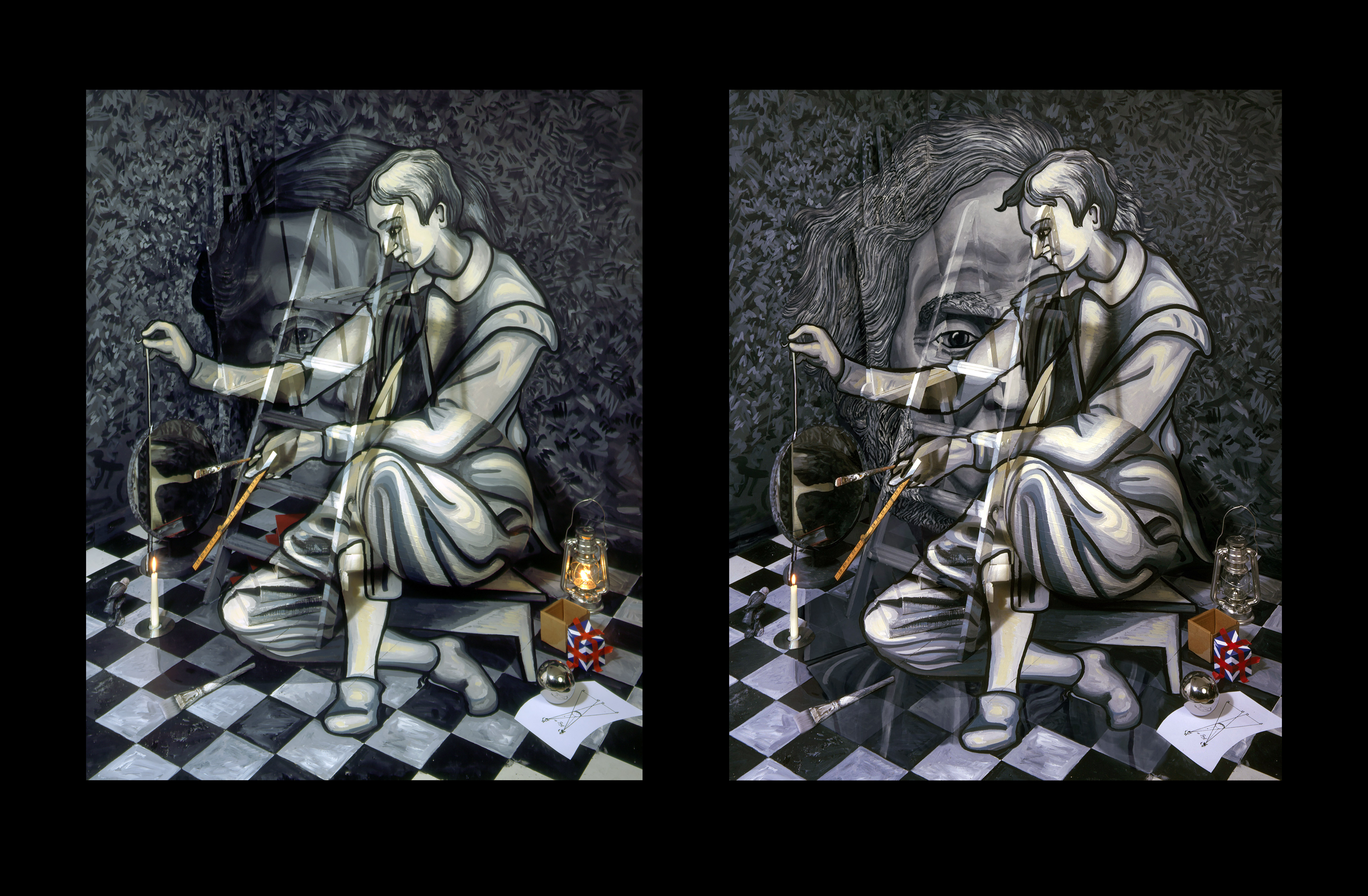
Review of the exhibition in The Scotsman on 9th March 2009.
Art-review-Calum-Colvin-Natural-Magic-News-Scotsman.com_Feature by Martin Kemp in NATURE|Vol 460|9 July 2009.
460179aInterview with students at St Andrews University Museums and Galleries Studies Course.
Questions-NaturalMagic-St-Andrews-Museums-and-Galleries-Studies-CoursePerception, 2009, volume 38, pages 633 ^ 637, by Professor Nicholas Wade.
p3805ed